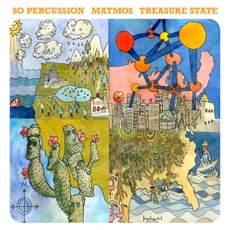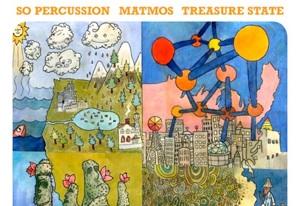
Ancient and modern music techniques collide in Treasure State, a collaboration between So Percussion and Matmos. Although drawn to the avant-garde, the So Percussion quartet’s music is firmly grounded in ancient rhythms and techniques. Banging on things is about as old as music gets. Matmos’ Drew Daniel and M.C. Schmidt, on the other hand, are masters of computer sampling and sequencing. Their imaginative recordings use unexpected sound sources, such as plastic surgery equipment, clumps of mud, and even a rat that once terrorized their apartment.
True collaborations can be tricky: how to create a new unique sound, while preserving and respecting the character of the collaborators? Treasure State gives the listener a gentle introduction. It starts with what seems like a very traditional piece built around a simple pentatonic melody. After establishing that, yes, this will be a percussion recording, with all the pedigree that the term implies, guest artist Mark Lightcap breaks in with a searing, feedback-driven squeal as if to announce “Let the games begin!” Not wanting to give up the game too soon, the song quickly eases back into familiar sonic territory.
Listen to the Music
Needles
Over the course of the first few tracks, the two groups twirl and dance around each other. It remains (seemingly) clear where the influences of the intersecting sounds come from. The second track, “Water,” combines literal sounds of steel drums and, you guessed it, water samples into something that, while not terribly adventurous, is certainly pretty. Eventually the combination yields real fruit with pieces like “Flame” (based on a heater unit) and “Shard” (based on ceramics). “Needles” is a particularly fascinating exercise. Source sounds for the piece come entirely from amplified cactus. The initial rhythmic pattern, played out on the needles, seems straightforward enough. As other sounds are added to the mix, a wholly unique soundscape is created. One of the great successes of the piece is how easy it is to forget its literal beginning.
Not forgetting the roots of percussion, the team does get to rock out on occasion, specifically in “Cross,” a piece boasting the most traditional instrument list on the album. That doesn’t mean you can identify what instrument is making which sound. One of the pleasures of any Matmos recording is guessing the sample sources. Fortunately, the liner notes provide ample information. For example, on “Aluminum” M.C. Schmidt is credited with “singing, rods, beer can, treadplate, brushes, editing.”
Ancient pedigree and cutting edge technology notwithstanding, in the end this album is just plain fun. It’s nice to hear the pleasure that So Percussion and Matmos take in their work. You can almost see their six heads bouncing along in unison to the rhythms with that hunched-over, completely absorbed body language of a rockin’ band. New musical concepts can sometimes seem more like medicine than entertainment. These guys seem to be having fun entertaining each other, and the feeling is infectious.

